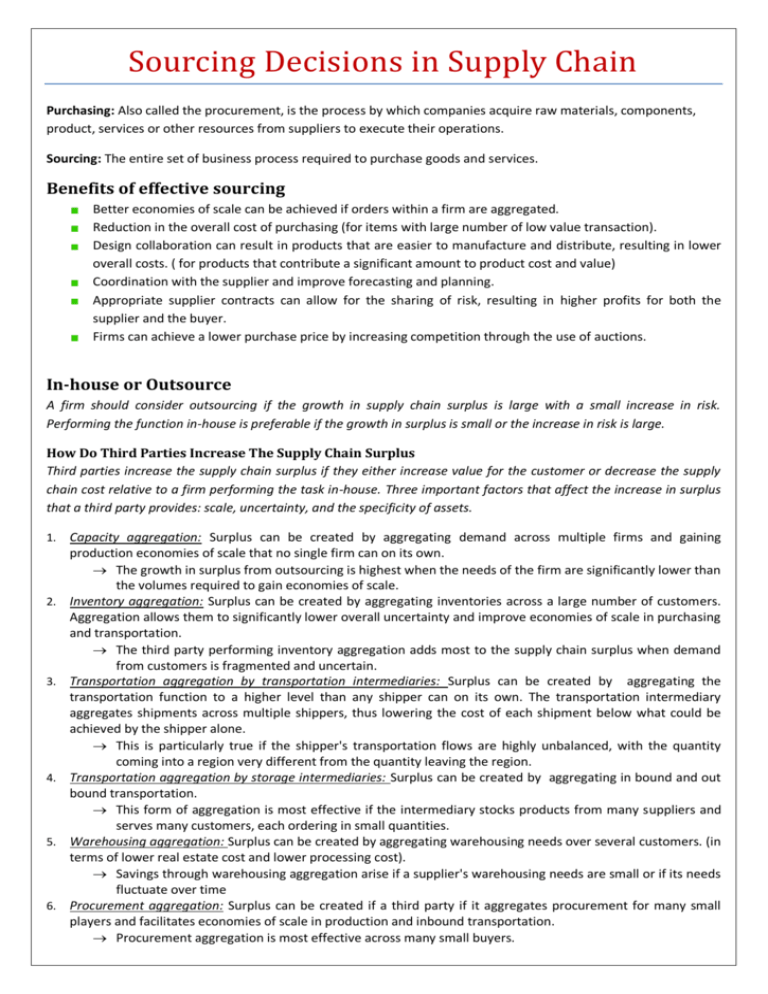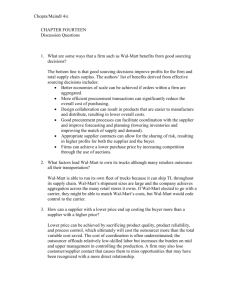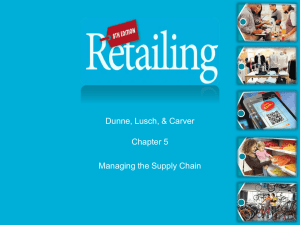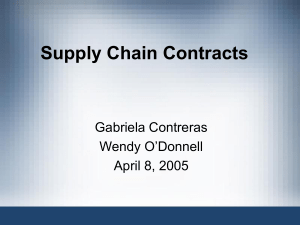Sourcing Decisions in Supply Chain Management
advertisement

Sourcing Decisions in Supply Chain Purchasing: Also called the procurement, is the process by which companies acquire raw materials, components, product, services or other resources from suppliers to execute their operations. Sourcing: The entire set of business process required to purchase goods and services. Benefits of effective sourcing Better economies of scale can be achieved if orders within a firm are aggregated. Reduction in the overall cost of purchasing (for items with large number of low value transaction). Design collaboration can result in products that are easier to manufacture and distribute, resulting in lower overall costs. ( for products that contribute a significant amount to product cost and value) Coordination with the supplier and improve forecasting and planning. Appropriate supplier contracts can allow for the sharing of risk, resulting in higher profits for both the supplier and the buyer. Firms can achieve a lower purchase price by increasing competition through the use of auctions. In-house or Outsource A firm should consider outsourcing if the growth in supply chain surplus is large with a small increase in risk. Performing the function in-house is preferable if the growth in surplus is small or the increase in risk is large. How Do Third Parties Increase The Supply Chain Surplus Third parties increase the supply chain surplus if they either increase value for the customer or decrease the supply chain cost relative to a firm performing the task in-house. Three important factors that affect the increase in surplus that a third party provides: scale, uncertainty, and the specificity of assets. 1. 2. 3. 4. 5. 6. Capacity aggregation: Surplus can be created by aggregating demand across multiple firms and gaining production economies of scale that no single firm can on its own. The growth in surplus from outsourcing is highest when the needs of the firm are significantly lower than the volumes required to gain economies of scale. Inventory aggregation: Surplus can be created by aggregating inventories across a large number of customers. Aggregation allows them to significantly lower overall uncertainty and improve economies of scale in purchasing and transportation. The third party performing inventory aggregation adds most to the supply chain surplus when demand from customers is fragmented and uncertain. Transportation aggregation by transportation intermediaries: Surplus can be created by aggregating the transportation function to a higher level than any shipper can on its own. The transportation intermediary aggregates shipments across multiple shippers, thus lowering the cost of each shipment below what could be achieved by the shipper alone. This is particularly true if the shipper's transportation flows are highly unbalanced, with the quantity coming into a region very different from the quantity leaving the region. Transportation aggregation by storage intermediaries: Surplus can be created by aggregating in bound and out bound transportation. This form of aggregation is most effective if the intermediary stocks products from many suppliers and serves many customers, each ordering in small quantities. Warehousing aggregation: Surplus can be created by aggregating warehousing needs over several customers. (in terms of lower real estate cost and lower processing cost). Savings through warehousing aggregation arise if a supplier's warehousing needs are small or if its needs fluctuate over time Procurement aggregation: Surplus can be created if a third party if it aggregates procurement for many small players and facilitates economies of scale in production and inbound transportation. Procurement aggregation is most effective across many small buyers. Information aggregation: Supply chain surplus can be increased by aggregating information to a higher level than can be achieved by a firm performing the function in-house. This information aggregation reduces search costs for customers. Information aggregation increases the surplus if both buyers and sellers are fragmented and buying is sporadic. 8. Receivables aggregation: Supply Chain surplus cab be increase if third party can aggregate the receivables risk to a higher level than the firm or it has a lower collection cost than the firm. Collecting receivables from each retail outlet is a very expensive proposition for a manufacturer. Receivables aggregation is likely to increase the supply chain surplus if retail outlets are small and numerous and each outlet stocks products from many manufacturers that are all served by the same distributor. 9. Lower costs and higher quality: A third party can increase the supply chain surplus if it provides lower cost or higher quality relative to the firm. If these benefits come from specialization and learning, they are likely to be sustainable over the longer term. A specialized third party that is further along the learning curve for some supply chain activity is likely to maintain its advantage over the long term. 7. A firm gains the most by outsourcing to a third party if its needs are small, highly uncertain and shared by other firms sourcing from the same third party. Risks of using a Third Party The process is broken Underestimation of the cost of coordination: The cost of the effort required to coordinate activities across multiple entities performing supply chain tasks. Reduced customer/supplier contact: The loss of customer contact is particularly significant for firms that sell directly to consumers but decide to use a third party to either collect incoming orders or deliver outgoing product. Loss of internal capability and growth in third-party power Leakage of sensitive data and information. Ineffective contracts: Contracts with performance metrics that distort the third party's incentives often significantly reduce any gains from outsourcing Supplier Scoring and Assessment When scoring and assessing suppliers, the following factors other than quoted price must be considered: Replenishment lead time: dictates the amount of inventory required On-time performance: affects the variability of the lead time and hence the safety stock Supply flexibility(variation in order quantity): less flexible the supplier, more lead-time variability it will display as order quantities change . Delivery frequency/minimum lot size: affect the size of each replenishment lot ordered by a firm - cycle and safety inventory Supply quality: Quality affects the lead time taken by the supplier order and also the variability of this lead time because follow-up orders often need to be fulfilled to replace defective products. Inbound transportation cost: The distance, mode of transportation, and delivery frequency affect the inbound transportation cost Pricing terms: allowable time delay before payment has to be made and any quantity discounts offered by the supplier- affects the working capital required. Information coordination capability: affects the ability of a firm to match supply and demand- reduces bull whip effect. Design collaboration capability: Given that a large part of product cost is fixed at design, collaboration capability of a supplier is significant Exchange rates, taxes, and duties Contracts and Supply Chain Performance To improve overall profits, the supplier must design a contract that encourages the buyer to purchase more and increase the level of product availability. This requires the supplier to share in some of the buyer's demand uncertainty. Three contracts that increase overall profits by making the supplier share some of the buyer's demand uncertainty are as follows: Buyback or returns contracts: A buy-back or returns clause in a contract allows a retailer to return unsold inventory up to a specified amount, at an agreed-upon price. Expected Manufacturer Profit = O* * (c - v) - (b - sM) * expected overstock at retailer c: wholesale price, b: buy back price, sM: Salvage Value, O*: Optimal Order Quantity In some instances, manufacturers use holding-cost subsidies or price protection to encourage retailers to order more. In the high-tech industry, in which products lose value rapidly, manufacturers share the risk of product becoming obsolete by providing price support to retailers. A downside to the buy-back clause (or any equivalent practice such as holding cost subsidy or price support) is that it leads to surplus inventory that must be salvaged or disposed. The task of returning unsold product increases supply chain costs. The cost of returns can be eliminated if the manufacturer gives the retailer a markdown allowance and allows it to sell the product at a significant discount. Revenue-Sharing Contracts: In revenue-sharing contracts, the manufacturer charges the retailer a low wholesale price c, and shares a fraction f of the retailer's revenue. Even if no returns are allowed, the lower wholesale price decreases the cost to the retailer in case of an overstock. The retailer thus increases the level of product availability resulting in higher profits for both the manufacturer and the retailer. If the production cost v, retail price p, salvage value is sR , optimal order quantity O*, where the cost of under stacking is Cu = (1 - f)p - c and the cost of overstocking is Cu = c - sR. We thus obtain Expected manufacturer's profits = (c - v) o* + fp( o* - expected overstock at retailer) Expected retailer profit = (1 - f)p( O* - expected overstock at retailer)+ SR * expected overstock at retailer - cO* One advantage of revenue-sharing contracts over buy-back contracts is that no product needs to be returned, thus eliminating the cost of returns. Revenue sharing contracts are best suited for products with low variable cost and a high cost of return. Revenue sharing contracts counter double marginalization by decreasing the cost per unit charged to the retailer thus decreasing the cost of over stocking. They increase information distortion and lead to lower retailer effort in case of over stocking, just as but back contracts do. Quantity Flexibility Contracts: Under quantity flexibility contracts, the manufacturer allows the retailer to change the quantity ordered after observing demand. If a retailer orders 0 units, the manufacturer commits to providing Q = (1 + α)O units, whereas the retailer is committed to buying at least q = (1 - β )O units. Both α and β are between 0 and 1. Quantity flexibility contracts are common for components in the electronics and computer industry. If the supplier has flexible capacity, a quantity flexibility contract increases profits for the entire supply chain and also each party. The quantity flexibility contract requires either inventory or excess flexible capacity to be available at the supplier. If the supplier is selling to multiple retailers with independent demand, the aggregation of inventory leads to a smaller surplus inventory with a quantity flexibility contract compared to either a buy-back or revenue-sharing contract. Relative to buy-back and revenue-sharing contracts, quantity flexibility contracts have less information distortion. Quantity flexible contracts counter double marginalization by giving the retailer the ability to modify the order based on improved forecasts closer to the point of sale. They result in lower information distortion than buy back or revenue contacts when a supplier sells to multiple buyers or supplier has excess flexible capacity. The Procurement Process There are two main categories of purchased goods: direct and indirect materials. Direct materials are components used to make finished goods. For example, hard drives, and CD drives. Indirect materials are goods used to support the operations of a firm. For eg: PCs. The procurement process for direct material should be focussed on improving visibility and coordination with the supplier. For indirect materials, the process should focus on decreasing the transaction cost for each order. The procurement process in both the cases should consolidate orders to take advantage of the economies of scale and quantity discounts. Based on the value and criticality of the product, they are classified into four groups: General Items: Low value, Low Criticality. Mostly Indirect Items. Aim: Lower the cost of acquisition. 2. Bulk purchase items: High value, Low Criticality. Method: well-designed auctions. 3. Strategic Items: Low value, High Criticality. Components with long lead times. Aim: ensure availability 4. Critical Items: High value, High Criticality. Aim: Long term buyer-supplier relationship 1. Risk Management in Sourcing Supply Disruption: developing multiple sources especially for products with high demand. Delay from suppliers: Carry inventory(low value items) or develop backup source(high value items). Higher procurement costs: have a portfolio of long- and short-term contracts Exchange-rate risk: using financial hedges or by developing a global supply network IP: keeping sensitive production in-house. maintain ownership of part of the equipment Making Sourcing Decisions in Practice Use multifunctional teams Ensure appropriate coordination across regions and business units. Always evaluate the total cost of ownership Build long-term relationships with key suppliers








